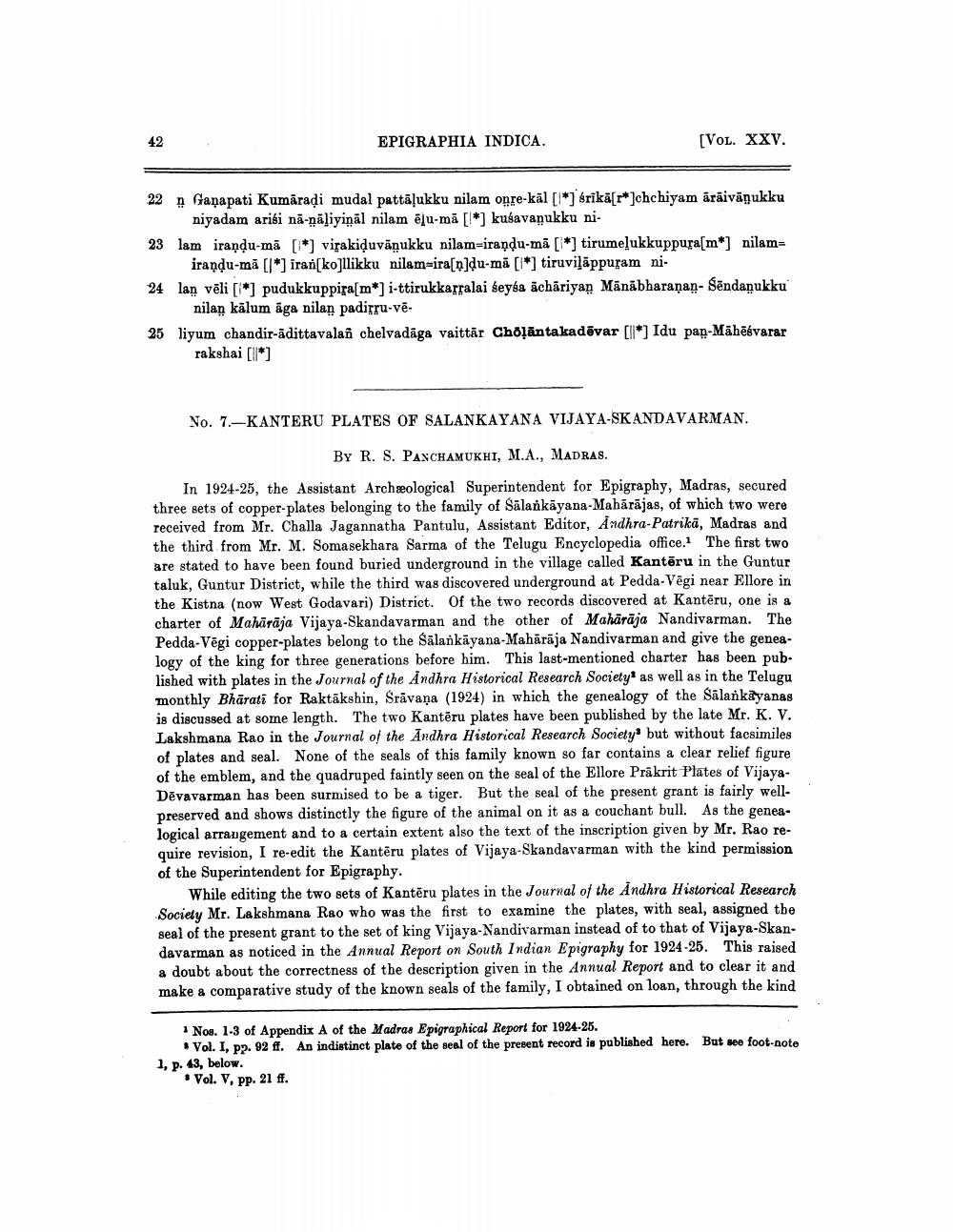________________
EPIGRAPHIA INDICA.
[Vol. XXV.
22 n Ganapati Kumāraời mudal pattāļukku nilam onre-käl [ *) érikā[T* ]chchiyam ārāivāṇukku
niyadam arisi nä-näliyināl nilam ēju-mă [*] kusavanukku ni. 23 lam irandu-mā [*] virakiduvāņukku nilam=iraņdu-mă [*] tirumelukkuppura[m*) nilam=
irandu-mă [l*) iran[ko]llikku nilam=ira[n]du-mā [l*] tiruviļāppuram ni. 24 lan vēli [ *) pudukkuppira[m*) i-ttirukkarralai seysa achariyan Mānābharaṇaḥ- Sēndanukku
nilan kālum aga nilan padiru-vē. 25 liyum chandir-ādittavalas chelvadāga vaittĀr Chöļāntakadēvar [11*] Idu pan-Mābēsvarar
rakshai (ll*]
No. 7.-KANTERU PLATES OF SALANKAYANA VIJAYA-SKANDAVARMAN.
By R. S. PANCHAMUKHI, M.A., MADRAS. In 1924-25, the Assistant Archæological Superintendent for Epigraphy, Madras, secured three sets of copper-plates belonging to the family of Salankäyana-Mahārājas, of which two were received from Mr. Challa Jagannatha Pantulu, Assistant Editor, Andhra-Patrikā, Madras and the third from Mr. M. Somasekhara Sarma of the Telugu Encyclopedia office. The first two are stated to have been found buried underground in the village called Kantöru in the Guntur taluk, Guntur District, while the third was discovered underground at Pedda-Vēgi near Ellore in the Kistna (now West Godavari) District. Of the two records discovered at Kantēru, one is a charter of Mahārāja Vijaya-Skandavarman and the other of Mahārāja Nandivarman. The Pedda-Végi copper-plates belong to the Sälarkāyana Maharaja Nandivarman and give the genealogy of the king for three generations before him. This last-mentioned charter has been published with plates in the Journal of the Andhra Historical Research Society as well as in the Telugu monthly Bhārati for Raktākshin, Srāvana (1924) in which the genealogy of the Sālankāyanas is discussed at some length. The two Kantēru plates have been published by the late Mr. K. V. Lakshmana Rao in the Journal of the Andhra Historical Research Society but without facsimiles of plates and seal. None of the seals of this family known so far contains a clear relief figure of the emblem, and the quadruped faintly seen on the seal of the Ellore Prakrit Plates of VijayaDévavarman has been surmised to be a tiger. But the seal of the present grant is fairly wellpreserved and shows distinctly the figure of the animal on it as a couchant bull. As the genealogical arrangement and to a certain extent also the text of the inscription given by Mr. Rao require revision, I re-edit the Kantēru plates of Vijaya-Skandavarman with the kind permission of the Superintendent for Epigraphy.
While editing the two sets of Kantēru plates in the Journal of the Andhra Historical Research Society Mr. Lakshmana Rao who was the first to examine the plates, with seal, assigned the seal of the present grant to the set of king Vijaya-Nandivarman instead of to that of Vijaya-Skandavarman as noticed in the Annual Report on South Indian Epigraphy for 1924-25. This raised a doubt about the correctness of the description given in the Annual Report and to clear it and make a comparative study of the known seals of the family, I obtained on loan, through the kind
But see foot-note
Nos. 1-3 of Appendix A of the Madras Epigraphical Report for 1924-25.
• Vol. I, pp. 92 ff. An indistinct plate of the seal of the present record is published here. 1, p. 43, below.
• Vol. V, pp. 21 ff.




